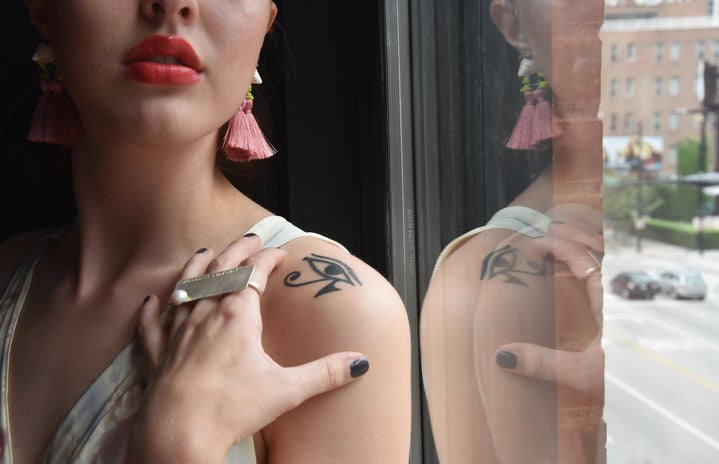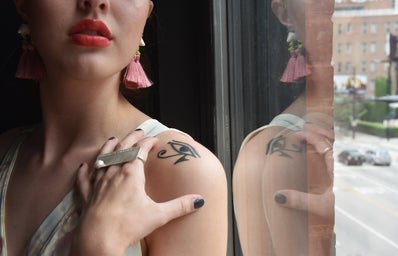If you are like me, you see people with gauges all the time, and you’ve become increasingly interested in getting them yourself. However, while looking at them, you begin imagining your worst fears: your ear tears off. No need to worry though! While that is always a possibility, as long as you do not strain your ears more than necessary, you should have no problem.
My personal experience with sizing up my ear holes has been with steel tapers and tunnels that I purchased from Amazon. The kit that I purchased came with tapers and tunnels from 14g to 00g, along with jojoba oil that was reasonably cost for a steel set. Unfortunately, a 14g was too large for my ear, so I had to purchase a 16g taper and plug.
Besides doing research on my own, I reached out to John, the owner of Eternity Tattoos in Royersford, Pennsylvania, to get more insight on ear stretching. As the owner of the tattoo parlor, John does both tattoos and piercings and has been in the industry for over 45 years. While talking with him, he told me about what it takes to be part of the tattoo and piercing industry. According to him, all one has to do in order to start and stay in the industry is to complete an apprenticeship, be CPR certified, and take a course in bloodborne pathogens.
- Key Terms
-
Blowout: This is a very common component while stretching your ears and happens when you try to size up before your ears are ready, causing scar tissue to form. You know you have a blowout when the hole gives the appearance of being turned inside out. This is normally in conjunction with sharp pain and inflammation (infection). There are many ways to treat a blowout. First is to go down two or three sizes of your gauges (if you are at a 4g go down to a 6g) and soak your ear in saline solution at least three times a day. In extreme cases, you might need surgery to fix the blowout.
Dermal Punching: This is probably the worst way of gauging your ears since this is none reversible. I personally did not look into this in great detail because it being a none reversible and not highly recommended by anyone. No one recommends it to the point that it is hard to find information on it.
Jojoba Oil: A lubricant help slide the tapers into your ears, along with the tunnels and plugs.
Ear Tearing: This is a terrifying thought since the only fix is to go get your lobes stitched back together. To help prevent this from happening, take care of your ears and make sure they are moisturized with plant-based oils like coconut or jojoba oil.
Tapers: These are the things most people use to stretch their ears. They’re cone-shaped (with a skinny side and a thick side) where the thickest part of it is the size of the gauge that you are stretching to. Normally there are two different o-rings on the tapers, these can be used as backings to keep the tapers in place for the stretching process. There are multiple different materials that these are made out of that you can use, and I’ll explain later the best material to use.
Tunnels: These are the things that you see people wearing that allow you to see straight through the stretched ears.
Plugs: These are the things that, obviously, plug the holes that are the stretched ears.
- Size Translation
-
John explained that the “standard earring gauge for an ear lobe is between 18-20, as the piercing gets wider the gauge size decreases.” So, 18 is the smallest gauge size and standardly where people have their ears pierced. From here, you decrease the size by 2, meaning the next size larger from 18 is 16. From 16 to 14, 14 to 12, and so on. This continues until the sizes get to a 00, which is about 3/8 inches. When you step up from a 00 size, the gauge sizes are measured in inches, and they increase by 1/16 of an inch.
The measurements of each gauge size from smallest to largest are the following:
18g (1 millimeter or 5/128 inches), 16g (1.2 millimeters or 3/64 inches), 14g (1.6 millimeters or 1/16 inches), 12g (2 millimeters or 5/6 inches), 10g (2.4 millimeters or 3/32 inches), 8g (3.2 millimeters or 1/8 inches), 6g (4 millimeters or 5/32 inches), 4g (5 millimeters or 3/16 inches), 2g (6 millimeters or 1/4 inches), 0g (8 millimeters or 5/16 inches), and 00g (10 millimeters or 3/8 inches).
Now, there are sizes large than a 00g. These are measured by inches, and the following are sizes from smallest to biggest in order for you to see how large gauges can become:
7/16 inches (11 millimeters), 1/2 inch (12 millimeters), 9/16 inches (14 millimeters), 5/8 inches (16 millimeters), 3/4 inch (19 millimeters), 7/8 inches (22 millimeters), 1 inch (25 millimeters), 1 and 1/8 inches (28 millimeters), 1 and 1/4 inches (32 millimeters), 1 and 3/8 inches (35 millimeters), 1 and 1/2 inches (38 millimeters), 1 and 5/8 inches (41 millimeters), 1 and 3/4 inches (44 millimeters), 1 and 7/8 inches (47 millimeters), and 2 inches (51 millimeters).
- get your own kit or go to a professional?
-
When it comes down to it, it’s up to you whether or not you go to a piercer or not. Personally, I did not because I’ve had some issues with my ears, and I don’t live near a piercer.
John told me that “on average, for the ear to be stretched, [it costs] typically anywhere between $15-30.” However, his shop, for the majority of the piercings that they do, costs around $25 which includes the cost of the jewelry.
- Where can I purchase a stretching kit?
-
You can purchase a stretching kit from any reputable website, or if you are careful, you can go through an Amazon seller. I went through Amazon because they were more cost-efficient. I was tempted to go with the cheapest set that I was going to find with good reviews. However, the material that your stretching kit and tunnels are is important.
Acrylic tapers are the cheapest ones that you will find, but they are more likely to carry bacteria and are extremely hard to clean. There are also numerous different places that say acrylic tapers, tunnels, and plugs are not good to wear for an extended period of time or at all due to them easily harboring bacteria. Also, in the event that your ear does tear, even if it is minor, you are more prone to get an infection.
Steel tapers are more expensive than acrylic, but they are easier to stretch with due to them being slicker than acrylic. Steel tapers are also very easy to clean since you can soak them in hot water and antibacterial soap or boil them, among other ways.
Concave Steel tapers are like steel tapers in the sense of cleaning and stretching. However, they have dips in the back of them that are used to put in your jewelry. Something I found while looking at these is that they are more expensive, but it seems that you are able to size up easier with them than with the other options.
John recommends steel, specifically 316l steel, because it’s non-porous which decreases the risk of infection. He does note that Acrylic, as I previously stated, is cheaper, but also porous, causing it to harbor dirt and bacteria. He also adds that wearing acrylic jewelry for long periods will also turn color.
- How long do you have to wait between stretches?
-
The answer changes depending on where you look, but it is standard to wait a minimum of four to six weeks between each stretch. You might have to wait longer depending on how your ears react to each stretch. The best advice I have here is to listen to your body. If you go to stretch and it is painful (close to bringing tears to your eyes), then your ears are not ready.
When I spoke with John, he noted that stretching your ears needs to be a slow, gradual process to avoid causing a blowout. Stretching the ears too large at once increases your risk of a blowout and infections. He also says that it’s recommended to only stretch one gauge size at a time and wait four to six weeks in between each stretch.
- How easily will my ears heal shut?
-
This depends on your ears themselves. The only way you can get them to heal shut is by wearing jewelry smaller than the size you are at. Once your ear heals shut to that point, you put in smaller jewelry until you are back to your normal piercing size or your preferred gauge size (as long as you are not past the point of no return). However, if your ears are not healing shut, you might have to look into surgery to get your ears to close up. If your ears heal shut at normal piercing and you don’t go past the point of no return, then you should have no problem getting them to heal shut.
- What is the point of no return?
-
The point of no return is a term for when you have stretched your ears so much that they will not heal shut on their own. Everyone’s point of no return is different. It just really depends on your ears. As previously stated, if your ears heal shut quickly with regular piercings, then your point of no return could be 1/2 inch (12 millimeters). If your ear holes do not heal shut easily, then your point of no return could be 2g (6 millimeters or 1/4 inch). However, the standard size that most people consider the point of no return is 00g (10 millimeters or 3/8 inch).
- What are Flares? what is their purpose?
-
Flares are the design of your tunnel or plug. If it is a single flare, then that means one side is flared out while the back is the same size as the middle and is held on by an O-ring. A double flare is when both ends are flared out (normally a size larger than where you are at) while the middle, or saddle, of the plug or tunnel, is the size you are currently at. A no-flare tunnel or plug is exactly what it sounds like. For a no-flare tunnel, the entire thing is one size, and there will be an O-ring on each side to hold it in your ear.
- How to stretch your ears?
-
Stretching your ears is a fairly easy process as long as you are not stretching too quickly. These instructions are based on having steel, single flare, tapers, and plugs. If you get acrylic, then there are different steps to take. So, if you have your kit and jojoba oil (or another natural oil), the following are the steps I’ve taken for my ears.
First, put antibacterial soap and hot water in a small container. Next, put your tapers and tunnels in the water to allow them to soak. Third, take a hot shower. The hot water will help blood flow and allow your ears to be more pliable for the stretch. After you shower, pull one taper out of the water (and rinse if there is soap on it) and put the jojoba oil on the taper and then your ear. From here, you should slowly push the taper through your piercing hole. There should be limited resistance until the taper is halfway through your ear. If the resistance is causing severe pain, pull the taper out and put the previous size back in, you are not ready to size up.
However, if there is minimum discomfort, push the taper through, stopping when it is almost all the way through your ear. Repeat with the other ear. Let your tapers sit for about five minutes, allowing your ears to adjust. Once those five minutes are up, put jojoba oil on your tunnel, placing the none flared end against the taper. Now slowly push the tunnel against the taper as you pull it out until the tunnel is situated in your ear, then put the O-ring on the back. Repeat with the other ear.
- How do I care for my stretched ears?
-
Now that you have your tunnels in your ear and you have successfully stretched your ears, you have to watch for signs of infection. These are normally shown by blood or puss coming out of the hole or your ear being inflamed and hot to the touch. However, to help avoid infections from happening, clean your fresh stretch with saline solution twice a day. You do this by lightly pushing the front/back of the tunnel against your ear while you rub a Q-tip with saline solution on it against the jewelry.
I asked John what his advice is for someone who is stretching their ears themselves, and he responded, “Wait until your original piercing is fully healed before even attempting to stretch, and make sure all equipment is properly sterilized.” Stretching ears takes a lot of care if you want your ears to be safe. He added, “Make sure not to stretch too much at once, increase your gauge incrementally and wait four to six weeks between each time you stretch.”
In summary, stretching your ears is a lot of work, and there is some risk associated with it, but as long as you are careful about stretching, then you should have no problems. If there is any information that is unclear or you want more details on, check the Healthline, Custom Plugs, Urban Body Jewelry, and Arctic Buffalo to fill in the gaps.


